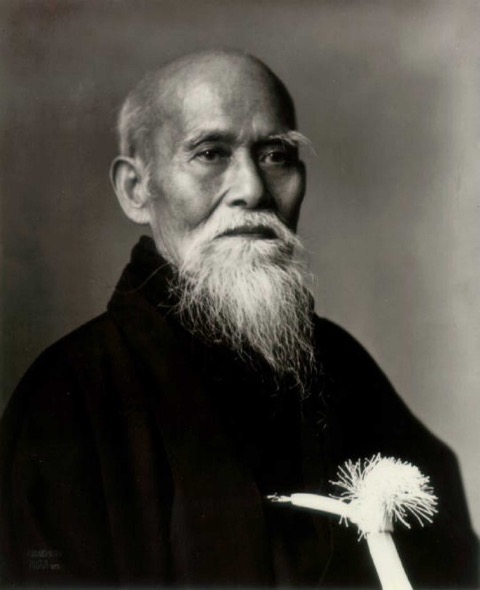Morihei Ueshiba
 Morihei Ueshiba (14 December 1883 – 26 April 1969). Philosopher, martial artist, author, and the creator of the discipline of Aikido. He is often referred to as O’Sensei (Great Teacher) by aikidoists.
Morihei Ueshiba (14 December 1883 – 26 April 1969). Philosopher, martial artist, author, and the creator of the discipline of Aikido. He is often referred to as O’Sensei (Great Teacher) by aikidoists.
Morihei Ueshiba was born in Tanabe, Wakayama Prefecture, Japan on 14 December 1883. During his childhood, the Ueshiba family lived in Maizuru (Kyoto Prefecture). His interest in martial arts stemmed from witnessing the beating of his father which affected him deeply. However, it was only after moving to the northern island of Hokkaido in 1912 with his wife, as part of a settlement effort, that his martial art training took on real depth. For it was here that he began his study of Daito-ryu aiki-jujutsu under its reviver Takeda Sokaku.
After Ueshiba left Hokkaido he came under the influence of Onisaburo Deguchi, the spiritual leader of the Omoto-Kyo religion in Ayabe. In addition to the effect on his spiritual growth, this connection was to have a major effect in introducing Ueshiba to various elite political circles as a martial artist. The Ueshiba Dojo in Ayabe was used to train members of the Omoto-Kyo sect. He was involved in the first Omoto-kyo Incident, an ill-fated attempt to found a utopian colony in Mongolia.
Although Ueshiba eventually distanced himself from both these teachers, their effect on him and his art can not be overstated. The real birth of Aikido came as the result of three Enlightenment experiences of Ueshiba. The first happened in 1925 after Ueshiba had defeated a naval officer’s bokken (wooden katana) attacks unarmed and without hurting the officer. Ueshiba then walked to his garden and:
“Suddenly, the ground began shaking. A golden vapour wafted up from the ground and enveloped me. I was transformed into a golden image, and my body felt as light as a feather. All at once I understood the meaning of creation: the Way of a Warrior is to manifest Divine Love, a spirit that embraces, loves, and protects all things.”
His second experience occurred in 1940 when:
“Around 2 am as I was performing misogi, I suddenly forgot all the martial techniques I had ever learned. The techniques of my teachers appeared completely new. Now they were vehicles for the cultivation of life, knowledge, and virtue, not devices to throw people with.”
His third experience was in 1942 during the worst fighting of WWII, Ueshiba had a vision of the “Great Spirit of Peace”:
“The Way of the Warrior has been misunderstood. It is not a means to kill and destroy others. Those who seek to compete and better one another are making terrible mistakes. To smash, injure, or destroy is the worst thing a human being can do. The real Way of a Warrior is to prevent such slaughter – it is the Art of Peace, the power of love.”
In 1927, Ueshiba moved to Tokyo where he founded his first dojo, which still exists today under the name Aikikai Hombu Dojo. Between 1940 and 1942 he made several visits to Manchukuo (Japanese-occupied Manchuria) to instruct his martial art. In 1942 he left Tokyo and moved to Iwama in the Ibaraki Prefecture where the term “Aikido” was first used as a name for his art. Here he founded the Aiki Shuren Dojo, also known as the Iwama dojo. During all this time he travelled extensively in Japan, particularly in the Kansai region teaching his Aikido.
Morihei Ueshiba died on 26 April 1969.
 Victoria Aikido Centre
Victoria Aikido Centre